Dispatching Cuban Tree Frogs
I'm sure everyone who posts on this forum knows my feelings about getting rid of Cuban Tree Frogs, so I won't go into any of that here. (You can do a search on the subject if you want more info on the reasons why I feel it necessary to try to get rid of them.)
I wanted to share some info I got from the Reptile Forum regarding humane ways of killing CTF's for those who are not comfortable with the big shovel approach. I don't have any experience with the freezer method myself, so I can't take an informed position on this, but these folks on the Reptile Forum generally know their stuff. Here is what I found there:
"DO NOT STICK THEM IN THE FREEZER!!!! - thats actually been proven to be a very inhumane and painful way to euthanize any reptile or amphibian and is banned from IUACUC practices as well as by the AZA and other organizations. The animals die very slowly and painfully as their blood crystalizes within their veins and arteries. That practice was popular even a few years ago, but researchers cringe at the thought they had committed countless animals to a very painful form of euthanasia.
As for the Orajel - just a large dab on the tip of your finger and rub it on their head. It basically numbs them and stops their brain from functioning, causing them to stop breathing and their heart to stop beating."
Because I have not been able to get outside and police my garden as I usually do, I now have a new clutch of frogs to deal with. I caught one in the net today and determined it was definitely a CTF. (Very large toepads, skin on head fused to skull, and the best evidence of all, blue bones.) I tried a drop of Orajel and the frog went completely still. He was dead in a couple of minutes, with no apparent pain or reaction.
Since I'm not a frog, I can't say what was going on in his little brain, but it WAS fast and easy. And prefereable in my mind to having frogs in my freezer. On the large CTF's, I will still use the "whackity-whack, don't talk back" method, since I don't think they even know what hit them. I'm pretty strong and accurate with my method, and I'm not bothered by it. But as I say, for those who aren't comfortable with that, you might give Orajel a try. It's cheap and a little dab'll do ya.
Please no big controversy here again on the pros and cons of dispatching these guys. Look up the previous posts and make your own decision accordingly. But if you ARE planning to eliminate them from your garden (for the sake of the green treefrogs and the green anoles), the above might be helpful.
Marcia
Comments (22)
abendwolke
15 years agolast modified: 9 years agothanks Marcia, I honestly thought the freezer would be ok, thinking 'humans' here.... Orajel and lots of it from now on. nope, the shovel makes such a splattering mess
manature
Original Author15 years agolast modified: 9 years agoGlad it gives you an option you like better than the freezer or shovel, Evelyn. It was really easy. The only hard part was catching the frog. I used a butterfly net.
(It worked great!)Marcia
Related Professionals
Montgomeryville Landscape Architects & Landscape Designers · Berwyn Landscape Contractors · Conroe Landscape Contractors · Dudley Landscape Contractors · Fort Atkinson Landscape Contractors · Golden Landscape Contractors · North Plainfield Landscape Contractors · Tewksbury Landscape Contractors · Alvin Decks, Patios & Outdoor Enclosures · Ashburn Decks, Patios & Outdoor Enclosures · Hampton Bays Decks, Patios & Outdoor Enclosures · Jackson Decks, Patios & Outdoor Enclosures · Surfside Decks, Patios & Outdoor Enclosures · Rosemont Siding & Exteriors · Kansas City Siding & Exteriorslaura1
15 years agolast modified: 9 years agoI haven't been seeing CTFs but the other day I saw two in the front yard and they both got away.
Question on ID-is there another frog that is that yeck brown grey death color? Do you have a pic or a link that shows CTF toes (that sounds funny) compared to green frogs?
thanks.
Lauralellie
15 years agolast modified: 9 years agoOh boy!
I was unaware of that info, Marcia...thanks.
Have takin' Frick & Frack, the latest hostages, out of the freezer and will go to CVS in a few for some Oragel...but HOW DO YOU PUT IT ON THEIR LITTLE HEADS without them getting away?
Hints, please.......and keep in mind...I'm NOT touching them...hehehe.
The two I caught today are in tupperware.abendwolke
15 years agolast modified: 9 years agoI use disposable gloves. Have a set sitting in the garage and when I see a CTF, I put them on and just go for it LOL... also, my frog trap (the big pvc pipe) works great.
manature
Original Author15 years agolast modified: 9 years agoGood ideas, Evelyn. Me, I just grab 'em when I can, or use the net and then take them out. I don't mind touching them if I have to. Of course, when I'm using the shovel method, my hands never make contact with them.
Lellie, here you go:
This is an American green treefrog, adult.
This is an adult Cuban treefrog, though not as big as they can get.
Keep in mind that the American green treefrog is always green, normally has a cream stripe down the side, and frequently has a few gold dots on its back. But basically, it is always bright green.
Cuban treefrogs can be greenish, mottled brown and green, or pasty, dead corpse-like gray-white. If you see one that color, it is not an American green treefrog, though we do have some other less common natives that can be greyish. Therefore, since the CTF has variable colors, it is really a good idea to look at the oversized toepads, check the skin on the top of the head, and if you can shine a light on them, check to see if the bones are blue. The skin on the head is fused to the bone on the CTF, and will slide around on our native treefrogs.
Small CTF's are greenish when newly morphed, but don't have a cream stripe down the side. Then they can 1)stay greenish, two turn mottled brown, or 3)begin to develop that dead white coloring. I don't know if each CTF can change from one color to the next, or if some are one color all the time and others, a different one. I'll see what I can find out on that.
Here are some CTF babies. (The smaller the frog, the harder it is to tell about those toepads).
And here are some young American green treefrogs.
I would say, when in doubt, don't kill it. Wait until you can identify it for certain. Hope this helps, somewhat.
Marcia
manature
Original Author15 years agolast modified: 9 years agoabendwolke
15 years agolast modified: 9 years agoGreat pictures Marcia, thanks!
about the gloves, I thought the CTF has a skin secretion that may cause irritation, so I don't want to take a chance, or am I confusing something here?babalu_aye
15 years agolast modified: 9 years agoI just grab them with my bare hands. Haven't noticed any irritation.
scottrell
15 years agolast modified: 9 years agoI too thank you for the info and the pics. I feel guilty now about freezing CTF's. I don't want them to suffer, I just want them gone. It is always a big event here at my house when someone catches one. I have already told the kids "No more frogs in the freezer!" Will have to try oragel from now on.
manature
Original Author15 years agolast modified: 9 years agoI'm glad some of you have found this method of dispatch to be more humane. That's great.
Evelyn, I have heard that said, too, but I have handled many of them, with no ill effects, and I have fairly sensitive skin. I'm wondering if possibly people have them confused with the Cane toads in south Florida, who are supposed to secret toxins through their skin? I'll have to double check, but so far, they have never irritated me.
Marcia
imatallun
15 years agolast modified: 9 years agoWow, thanks for the info, Marcia, greatly appreciated.
I pasted this from the UF website and it brings up the skin rash/gloves/application methods above. My question is if the Orajel actually kills them, or if it just puts them in an anesthetic "coma" for awhile, allowing them to come back and terrorize our beloved natives. I've never been able to get them with a shovel, because I've found them in bromeliad cups, trees or plants. Anyway, here's the paste... (And if you're North of Orlando please note the request made for notification of CTF siting).
What You Can Do for Florida
Due to the destructive effects Cuban treefrogs have on native species of amphibians and reptiles, many biologists recommend that Cuban treefrogs be euthanized/killed. That's harsh, but true. We recommend a humane method of euthanasia for amphibians. Just make SURE the frog you have is a Cuban treefrog before euthanizing it (see the test suggested below).A humane method for euthanizing amphibians:
To euthanize a Cuban Treefrog, hold the frog firmly in your hand and apply a 1 inch bead of benzocaine ointment along the back of the frog. Benzocaine ointment is a topical anesthetic (a numbing agent) used to treat skin pain (e.g., from sunburn) and itching as well as toothaches and sore throats. There are a variety of name brand and generic versions that are available over-the-counter in a tube or spray. If you are able to, using a gloved finger spread the ointment out on the frog's back. Alternatively, you could use a benzocaine spray. Once the ointment or spray is applied, place the frog in a plastic grocery bag or a sealable sandwich bag for 15-20 minutes so that the benzocaine has a chance to render the frog unconscious (be sure to seal the bag or tie it closed). After the bezocaine has anesthetized the frog, place the bag in a freezer overnight to ensure that the frog is dead and then throw it out in your trash. If you are unable to apply benzocaine to the frog, you can simply put it in a plastic bag, seal or tie the bag shut, then place it in the freezer overnight--dispose of the bag and the frog in the trash the next day. Do not throw a bagged frog into the trash without euthanizing it first. Remember, Cuban Treefrogs have a noxious skin secretion so be sure to wash your hands thoroughly after you handle the frog, even if you wear gloves or use a plastic bag.Freezing is a humane way to kill amphibians because their bodies go into a state of torpor (metabolism slows way down) -- just as they do in cold weather outside. If the cold weather is short in duration, the frogs will come out of their torpor state. However, after an extended time in freezing temperatures, the frogs die.
A good test to determine if a frog is a Cuban treefrog is to grasp the frog firmly, but gently, and try to move the skin around on the top of the frog's head with your fingertip. The skin on the head of a Cuban treefrog is fused to the top of the skull and won't move.
Be sure to wash your hands after handling any frog or toad. They all secrete a slimy film to protect their skin, but the secretions of some species, like the Cuban treefrog, can irritate the skin and eyes of some people.
If you live north of Orlando (FL) and you think you have Cuban treefrogs in your yard, send a description or digital photo of the frog(s) via email to extension@wec.ufl.edu. We are assisting a herpetologist from the U.S. Geological Survey with mapping the distribution of this species as it expands its range.
Here's the website if anyone wants more pics. Marcia, I'm pretty sure you gave me this website originally...thanks.
http://www.wec.ufl.edu/extension/wildlife_info/frogstoads/osteopilus_septentrionalis.php
Marilyn
manature
Original Author15 years agolast modified: 9 years agoThanks, Ima! Glad to have all that info. One thing...apparently many experts have discarded the notion that freezing reptiles is painless and have updated their procedures to the benzocaine/Orajel method. Orajel is 20% benzocaine, and believe me the little frog I had this morning was bloomin' DAID! You can see right through them at that stage, and his heart quit beating completely. I disposed of the body in a bag and put it in the trash. No chance he'll wake up and hop around my yard any more.
As to the skin irritation thing, perhaps the reason it has never bothered me is because I routinely wash my hands thoroughly after handling just about anything in the yard. I probably was my hands 30 times a day anyway. Maybe more. I don't like the feel of dirt on my hands (it dries my skin terribly) and I sure don't like the wet feel of frogs and critters that I might have reason to handle. So perhaps the possible irritant has never had a chance to bother me, I don't know. But by all means, if anyone is worried about that or just doesn't want to "feel" frog skin, grab those disposable gloves Evelyn mentioned. Easy solution.
And don't forget, in addition to the skin on the head, CTF's have blue bones (those were clearly visible in the baby frog, right through his skin), and much larger toepads than native frogs. But again, if you aren't SURE, I would say don't kill the frog.
Marcia
manature
Original Author15 years agolast modified: 9 years agoAs I say, Evelyn, experts DID suggest freezing for some time, but now most are agreed that it is a painful death for reptiles and amphibians. Orajel/benzocaine is considered a much kinder way to go. It is certainly faster, and doesn't fill up your freezer with frogs. (With my luck, Mark would be trying to nuke them for lunch!) I suspect the above info just hasn't been updated yet.
Marcia
imatallun
15 years agolast modified: 9 years agoNot to get technical or anything, but I know that that website I pasted has been updated significantly since you provided it in July, Marcia. Back then they recommended freezing for 3 days. They mentioned but didn't emphasize the benzocaine cream, never mentioned the spray, I like how they're recommending reusing plastic grocery store bags now, too.
LOL re Mark. Your dh sounds like my d boyfriend. My Danny would undoubtedly nuke and serve with left over potato salad. (Except I make him do the capture when he's here, and we always use the publix peanuts can in the Frigidair.)
I think (when Danny isn't around), I'll go for spraying with benzocaine (Walgreens, etc. has a knock off version of throat spray), picking it up with garden or plastic gloves, deposit in a used plastic grocery bag, which I'll knot, freeze until the night before garbage gets picked up. Oh, and wash my hands thereafter. (My skin isn't sensitive, but my eyes are.)
I'm seeing fewer of them, and really again have to thank Marcia for all the posts and education about CTF's and Cuban Marine Toads. Yay M!
Marilyn
manature
Original Author15 years agolast modified: 9 years agoMarilyn, it might be that the folks you quoted haven't changed their minds yet on freezing. As the quote I found says "most" experts have retracted that advice. But some may still be using it. I think the spraying with Benzocaine first is a good idea. It should kill them within minutes, and if you decide to freeze them for good measure, it won't hurt them at that point. Me, I'm going to use some product or other with benzocaine, be it Orajel or generic chloroseptic, and then I'm tying them up in a bag and dropping in the garbage can. (I don't want to find their skinny little blue-boned legs served up to me on a salad plate! ACK!!)
I'm glad to have been of some help to ya, Marilyn, though I can't say I know much about the Marine toads (cane toads). I haven't ever seen one up here, and I hope I never do! I have enough going on with the CTF's, and other exotics that I've learned to live with. (Those brown anoles are a lost cause, I think, but at least the Carolinas are coming back.) Any way, I learn SO much from all the knowledgeable people on this forum that it feels great to be able to share some things in return. After so many years with Florida Audubon, I picked up a lot of good info on birds, reptiles, and the like. I love to pass it along in the hopes that other gardeners will find it as interesting as I do.
Marcia
manature
Original Author15 years agolast modified: 9 years agoHmmmm...maybe you could sneak it onto their pizza and see? Or smear it on their cellphone...direct contact with the ears?
*grin*
Marcia
katfla
14 years agolast modified: 9 years agoLast spring I installed a round preformed pond (30 gal) and waited patiently (nearly a year) for the frogs to come. Last Saturday I noticed the first egg masses, which have since hatched. Unfortunately, I've verified the frog calls I heard. It appears my lovely new "babies" are Cuban TFs..... *sigh*
Today, I fed some to my goldfish (indoors). I don't know what I shall do about the others. :(
katfla
14 years agolast modified: 9 years agoUpdate: Today I noticed a healthy population of water beetle larvae in the little pond.... the tadpoles appear to be fewer in number (or possibly hiding). I may not have to "dispatch" them after all!
flatsguide_bellsouth_net
13 years agolast modified: 9 years agohow do you catch them in the pvc pipe? I can hear them all night, but can't find them in the daytime... someone mentioned a pvc pipe... do i just hang it where i hear them? what size length diameter? .. do i have to paint it to disguise it? thanks~ the noise is driving me crazy!







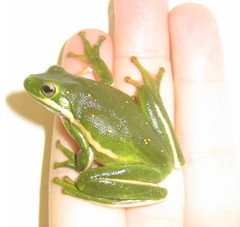
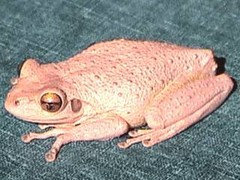
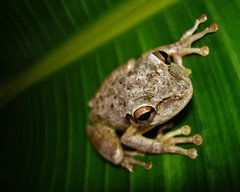
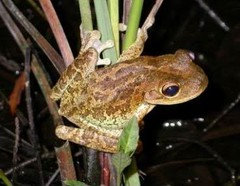
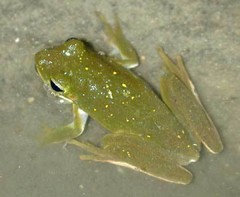
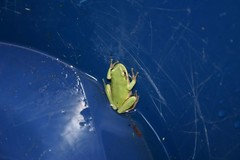
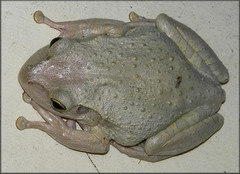
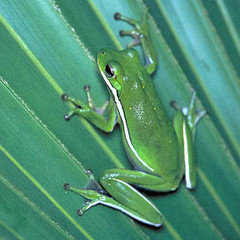


billbrandi